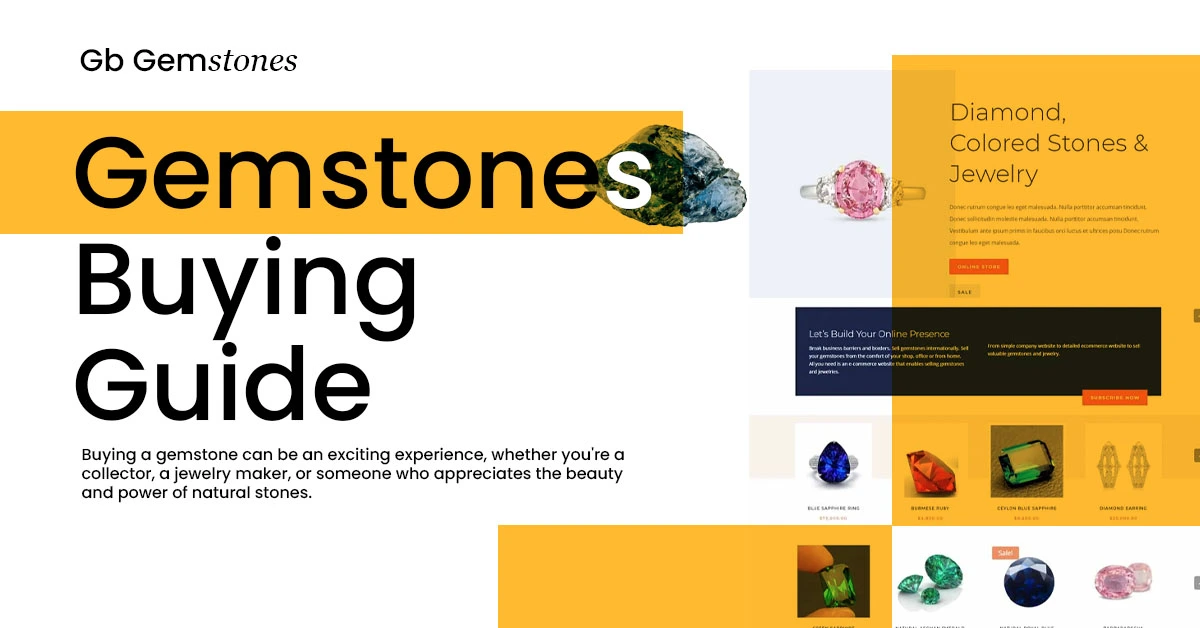Buying a gemstone can be an exciting experience, whether you’re a collector, a jewelry maker, or someone who appreciates the beauty and power of natural stones. But with so many options available, knowing what to look for and where to start can feel overwhelming. This gemstone buying guide will help you make informed decisions and choose the perfect gemstone that suits your needs, whether for its aesthetic, spiritual, or monetary value. By following this gemstone buying guide, you’ll be equipped with the knowledge to make confident and smart purchases.
Understand the Types of Gemstones
Gemstones come in two broad categories: precious and semi-precious stones. Knowing the difference will help narrow down your options based on your purpose and budget.
- Precious Gemstones: These include diamonds, emeralds, rubies, and sapphires. They are rarer and often more expensive, making them highly sought-after for fine jewelry.
- Semi-Precious Gemstones: These include stones like amethyst, aquamarine, garnet, topaz, and tourmaline. Semi-precious gems are more affordable but still offer stunning beauty and unique properties.
Consider the 4Cs: Color, Cut, Clarity, and Carat Weight
When buying a gemstone, the 4Cs, a system used to evaluate diamonds, can also apply to colored stones. Understanding these factors helps assess the stone’s quality and value.
- Color: For gemstones, color is often the most important factor. Look for vivid, even color tones without too much darkness or lightness. Each gemstone has its ideal color range; for example, emeralds should have a deep green hue, while sapphires are best in a royal blue tone.
- Cut: The cut of a gemstone determines how well it reflects light. A well-cut gemstone will sparkle and catch the eye. Keep in mind that some gemstones, especially rough or raw ones, may come in uncut forms.
- Clarity: Inclusions (natural imperfections) are common in gemstones, but fewer inclusions generally mean a higher value. However, some inclusions can enhance the uniqueness of a gem, like star sapphires or cat’s eye chrysoberyl.
- Carat Weight: This measures the gemstone’s size. Larger stones are rarer and more valuable, but smaller stones can still have excellent color and brilliance.
Know the Purpose of Your Gemstone
Before buying, consider what the gemstone will be used for. Is it for a special piece of jewelry, an addition to your collection, or for spiritual or healing purposes?
- Jewelry: If you’re purchasing a gemstone for a ring, necklace, or other jewelry, make sure the stone is durable enough to withstand daily wear. Harder stones like diamonds, sapphires, and rubies are ideal for rings, while softer stones like opals may be better suited for pendants or earrings.
- Collecting: If you’re a collector, rarity and uniqueness may be more important than the gemstone’s wearability. You might seek out raw, uncut stones or unusual specimens like rare garnets or alexandrite that change color in different lighting.
- Spiritual Use: Many people buy gemstones for their metaphysical properties. For example, rose quartz is known for promoting love and harmony, while amethyst is believed to calm the mind. Research the meanings behind different gemstones if you’re drawn to their spiritual energy. (International Gem Society)
Decide Between Natural vs. Lab-Created Gemstones
Natural gemstones are formed in the earth over millions of years, while lab-created gemstones are grown in controlled environments. Both are real stones, but lab-created gems tend to be more affordable because they are less rare.
- Natural Gemstones: These stones are valued for their rarity, uniqueness, and the fact that they are formed by natural processes. They may have more inclusions, which can sometimes add character to the stone.
- Lab-Created Gemstones: Lab-grown stones offer the same chemical composition and physical properties as natural stones but at a lower cost. They are a great option if you want the look of a gemstone without the price tag of a natural stone.
Buy from Reputable Sources
When purchasing gemstones, especially high-value stones, always buy from reputable sellers. Look for companies that provide certification from recognized gemological labs like GIA (Gemological Institute of America) or AGL (American Gemological Laboratories). These certificates verify the gemstone’s authenticity, characteristics, and value.
Online marketplaces can be convenient, but make sure the seller offers guarantees, return policies, and clear descriptions of their gemstones. Trusted sources, such as Gem Rock Auctions, The Raw Stone, and Rio Grande, offer certified gemstones and have positive reputations among buyers. (Gem Rock Auctions)
Ask for a Certificate of Authenticity
Whether you’re buying a diamond or an amethyst, always ask for a certificate of authenticity. This certificate provides details about the gemstone, including its grade, origin, and whether it has undergone any treatments. For expensive purchases, certificates from labs like GIA can provide peace of mind that you’re getting a quality stone.
Be Aware of Treatments and Enhancements
Many gemstones on the market have been treated to improve their color or clarity. Common treatments include heat treatment for sapphires and rubies, oiling for emeralds, and irradiation for topaz. While treated stones can still be beautiful and valuable, untreated stones generally command higher prices.
Make sure to ask the seller if the gemstone has undergone any treatments. This transparency will help you understand what you’re buying and how it compares to untreated gems. (American Gem Trade Association)
Understand the Pricing
Pricing for gemstones can vary significantly based on several factors, including type, rarity, quality, and size. Do your research to understand the price range for the gemstone you’re interested in, and make sure you’re comparing stones of similar quality. Be cautious of deals that seem too good to be true, as they might indicate synthetic stones or low-quality gems.
Trust Your Instincts
Finally, choose a gemstone that speaks to you. Whether it’s the color, shape, or energy that draws you in, trust your gut when making your decision. After all, gemstones are meant to bring beauty and joy into your life.
Conclusion
Buying a gemstone can be a rewarding experience, whether you’re looking for a stunning addition to your jewelry collection or a meaningful stone for its spiritual properties. By following this gemstone buying guide and understanding key factors like gemstone types, the 4Cs, natural vs. lab-created stones, and where to buy from, you’ll be able to choose the perfect gemstone with confidence. Always purchase from reputable sources, and don’t forget to consult this gemstone buying guide to ensure you ask for certification to guarantee authenticity.

